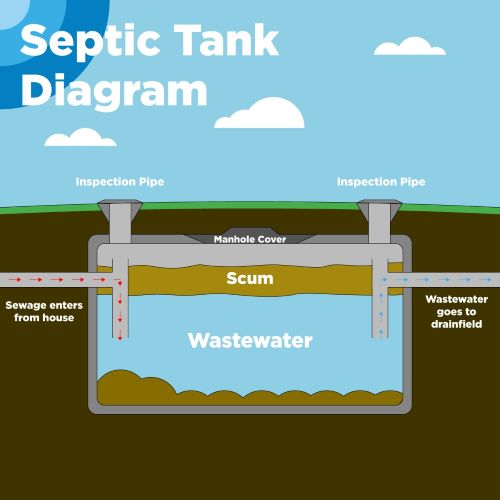How to look after your septic tank to treat your household wastewater
18 March 2025 14:28

If you live in the countryside and your house is not connected to an NI Water sewer, it is most likely discharging wastewater into a septic tank on your property.
Septic tanks are small wastewater treatment plants for your home. It is a ‘living’ treatment system which depends on the presence of good bacteria to break down waste coming from your home.
It is important to look after your septic tank to ensure it is operating correctly to prevent pollution to the water environment or problems with treating waste coming from your house. It can be costly to repair a failed septic tank, so good ongoing maintenance is essential.
Below are some tips to help you find your septic tank and understand if it needs de-sludged:
- Don’t know where your septic tank is? Don’t worry: Look for a metal or concrete lid - this may be overgrown or have become covered with soil. Your tank will normally be downhill from your property. Your title deeds will show where it is.
- You will need to register your septic tank with DAERA via www.daera-ni.gov.uk/articles/regulating-water-discharges if you have not already done so. To ensure your septic tank is in good working order, perform these checks regularly.
- Check the drains around your home. Are they slow at clearing or are your toilets blocking up? This could indicate your septic tank is full or the soakaway is blocked.
- At the tank, make sure the cover is accessible. There should not be a smell from the tank. If the tank needs to be emptied, it may start to leak.
- Check the discharge pipe for appearance and odours. A smelly or dark discharge pipe indicates a likely problem. This could be caused by a build-up of sludge, blocked pipes, or too many chemicals being added to the tank which have killed the bacteria required for the treatment process. Get it checked by a specialist if you see any of these problems.
- If you find fungal growth such as slime in the watercourse or smell odour coming from a nearby watercourse, it may be that your septic tank is releasing untreated sewage. Check the tank and pipes for any signs of damage and contact a plumber to fix the problem.
Did you know that NI Water provide one FREE de-sludging service for domestic customers for your septic tank per year? Further details are available via https://digitalservices.niwater.com/desludge-open This service empties up to 4.5m3 of sludge from your tank (subject to access), aiming to carry out the service within 12 days, leaving enough to keep the living treatment process working efficiently.
There are also ways to maximise the life of your septic tank and reduce its effect on the environment:
- Have your septic tank de-sludged regularly - record any dates of maintenance.
- Don’t drive over the soakaway or build anything above it (concrete or tarmac)
- Only use household cleaning products labelled as ‘suitable for septic tanks’, ‘environmentally friendly’ or ‘low phosphate’. Chlorine bleaches are not recommended for use with a septic tanks as bleach can kills the bacteria needed to treat your wastewater.
- Use a sink strainer to stop solids going down waste pipes
- Use less water by flushing less or using a dual flush toilet
- Only flush the 3 P’s (pee, poo and paper) down toilets
- In the kitchen, do not pour grease or cooking oil down the sink
- Plant trees and shrubs well away from your septic tank, as the roots can block up soakaways and drains.
For more information or to book your de-sludge go to www.niwater.com/siteFiles/resources/pdf/2024/SepticTankInformation.pdf and also at www.niwater.com/arrange-septic-tank-emptying/
Ends
Notes to editors
Septic tanks work so that waste coming from your home it is no longer harmful and can be discharged into a nearby waterway or soakaway (the area where the treated tank water goes to soak away). The tank is usually a two or three chamber structure, which retains sewage from your property for enough time to allow solids to form into sludge at the base of the tank, where it is partly broken down by bacteria. The remaining liquid drains from the tank by an outlet pipe and soakaway.
Media enquiries to the NI Water Press Office via email to press.office@niwater.com